D3 doesn't offer anything that can really help here. Vanilla javascript can achieve this fairly easily. First let's create a geojson ellipse in Cartesian coordinate space. After, we can use the haversine formula to draw the ellipse.
- Create a geojson ellipse in Cartesian coordinate space.
This is pretty straightforward, the method I'm using is to calculate the radius of the ellipse at a given angle. Using these polar coordinates we can stitch together an ellipse. The formula for the radius of an ellipse at a given point can be found pretty easily, I used this source, which gives us:

So, we can easily iterate through a series of angles, calculate the radius at that angle, and then translate this polar coordinate into a Cartesian coordinate. Perhaps something like:
function createEllipse(a,b,x=0,y=0,rotation=0) {
rotation = rotation / 180 * Math.PI;
var n = n = Math.ceil(36 * (Math.max(a/b,b/a))); // n sampling angles, more for more elongated ellipses
var coords = [];
for (var i = 0; i <= n; i++) {
// get the current angle
var θ = Math.PI*2/n*i + rotation;
// get the radius at that angle
var r = a * b / Math.sqrt(a*a*Math.sin(θ)*Math.sin(θ) + b*b*Math.cos(θ)*Math.cos(θ));
// get the x,y coordinate that marks the ellipse at this angle
x1 = x + Math.cos(θ-rotation) * r;
y1 = y + Math.sin(θ-rotation) * r;
coords.push([x1,y1]);
}
// return a geojson object:
return { "type":"Polygon", "coordinates":[coords] };
}
Note: a/b: axes (in pixels), x/y: center (in pixels), rotation: rotation in degrees
Here's that in a quick snippet:
var geojson = createEllipse(250,50,200,200,45);
var svg = d3.select("body")
.append("svg")
.attr("width",600)
.attr("height",500);
var path = d3.geoPath();
svg.append("path")
.datum(geojson)
.attr("d",path);
function createEllipse(a,b,x=0,y=0,rotation=0) {
rotation = rotation / 180 * Math.PI;
var n = n = Math.ceil(36 * (Math.max(a/b,b/a))); // n sample angles
var coords = [];
for (var i = 0; i <= n; i++) {
// get the current angle
var θ = Math.PI*2/n*i + rotation;
// get the radius at that angle
var r = a * b / Math.sqrt(a*a*Math.sin(θ)*Math.sin(θ) + b*b*Math.cos(θ)*Math.cos(θ));
// get the x,y coordinate that marks the ellipse at this angle
x1 = x + Math.cos(θ-rotation) * r;
y1 = y + Math.sin(θ-rotation) * r;
coords.push([x1,y1]);
}
// return a geojson object:
return { "type":"Polygon", "coordinates":[coords] };
}
<script src="https://cdnjs.cloudflare.com/ajax/libs/d3/4.13.0/d3.min.js"></script>
- Apply the haversine formula.
One of the best resources on the haversine and related functions I know of is at Moveable Type Scripts. The formula I have came from there a few years back and has had a few cosmetic modifications. I'm not going to break down the formula here, as the linked reference should be useful.
So, rather than calculating the Cartesian coordinates, we can take the polar coordinate and use the angle as bearing and the radius as distance in the haversine formula, which should be relatively trivial.
This could look like:
function createEllipse(a,b,x=0,y=0,rotation=0) {
var k = Math.ceil(36 * (Math.max(a/b,b/a))); // sample angles
var coords = [];
for (var i = 0; i <= k; i++) {
// get the current angle
var angle = Math.PI*2 / k * i + rotation
// get the radius at that angle
var r = a * b / Math.sqrt(a*a*Math.sin(angle)*Math.sin(angle) + b*b*Math.cos(angle)*Math.cos(angle));
coords.push(getLatLong([x,y],angle,r));
}
return { "type":"Polygon", "coordinates":[coords] };
}
function getLatLong(center,angle,radius) {
var rEarth = 6371000; // meters
x0 = center[0] * Math.PI / 180; // convert to radians.
y0 = center[1] * Math.PI / 180;
var y1 = Math.asin( Math.sin(y0)*Math.cos(radius/rEarth) + Math.cos(y0)*Math.sin(radius/rEarth)*Math.cos(angle) );
var x1 = x0 + Math.atan2(Math.sin(angle)*Math.sin(radius/rEarth)*Math.cos(y0), Math.cos(radius/rEarth)-Math.sin(y0)*Math.sin(y1));
y1 = y1 * 180 / Math.PI;
x1 = x1 * 180 / Math.PI;
return [x1,y1];
}
// Create & Render the geojson:
var geojson = createEllipse(500000,1000000,50,70); // a,b in meters, x,y, rotation in degrees.
var geojson2 = createEllipse(500000,1000000)
var svg = d3.select("body")
.append("svg")
.attr("width",600)
.attr("height",400);
var g = svg.append("g");
var projection = d3.geoMercator().translate([300,200]).scale(600/Math.PI/2);
var path = d3.geoPath().projection(projection);
g.selectAll("path")
.data([geojson,geojson2])
.enter().append("path")
.attr("d", path);
g.selectAll("circle")
.data([[50,70],[0,0]])
.enter().append("circle")
.attr("cx", function(d) { return projection(d)[0] })
.attr("cy", function(d) { return projection(d)[1] })
.attr("r", 4)
.attr("fill","orange");
<script src="https://cdnjs.cloudflare.com/ajax/libs/d3/4.13.0/d3.min.js"></script>
Note: a/b axes in meters, x,y,rotation in degrees
That's a pretty boring demonstration, perhaps this simple demonstration is better:

The formula I'm using assumes a earth is a sphere, not an ellipsoid, this can lead to errors in distance of up to 0.3%. However, depending on map scale, this will often be less than the stroke width.
I might have to try and make a particularly visually challenging version of a tissot's indicatrix with this
Snippets use default parameter values that are not compatible with IE, example block offers IE support

